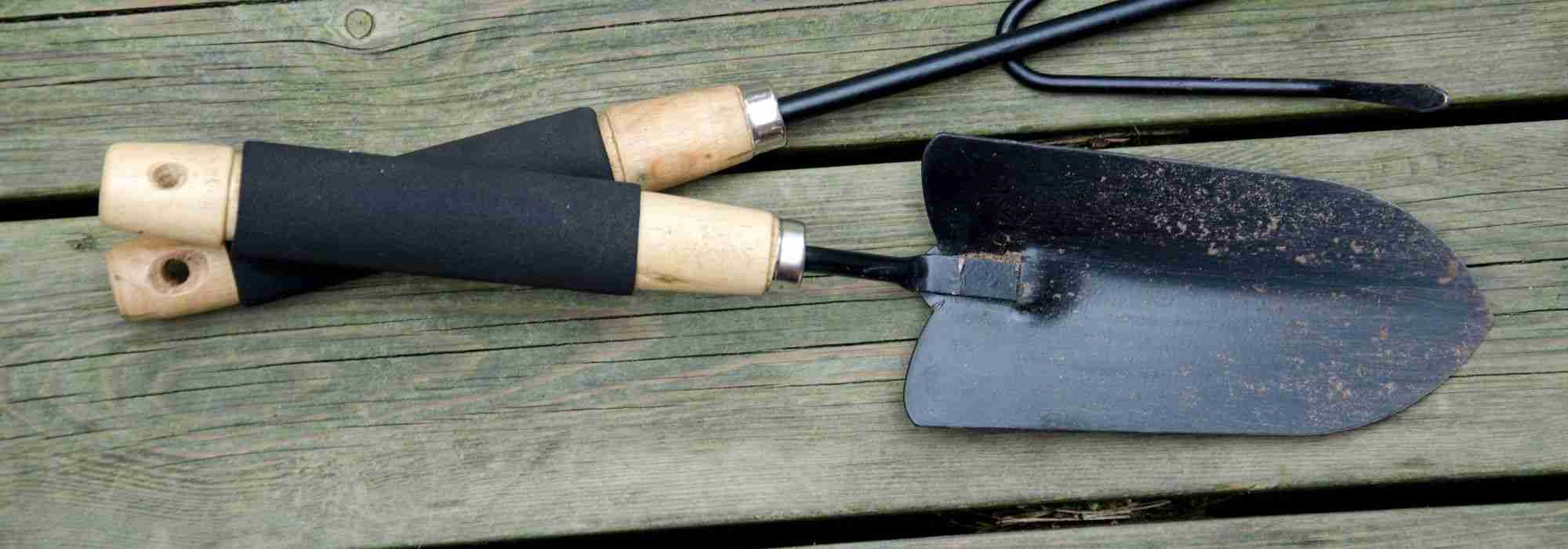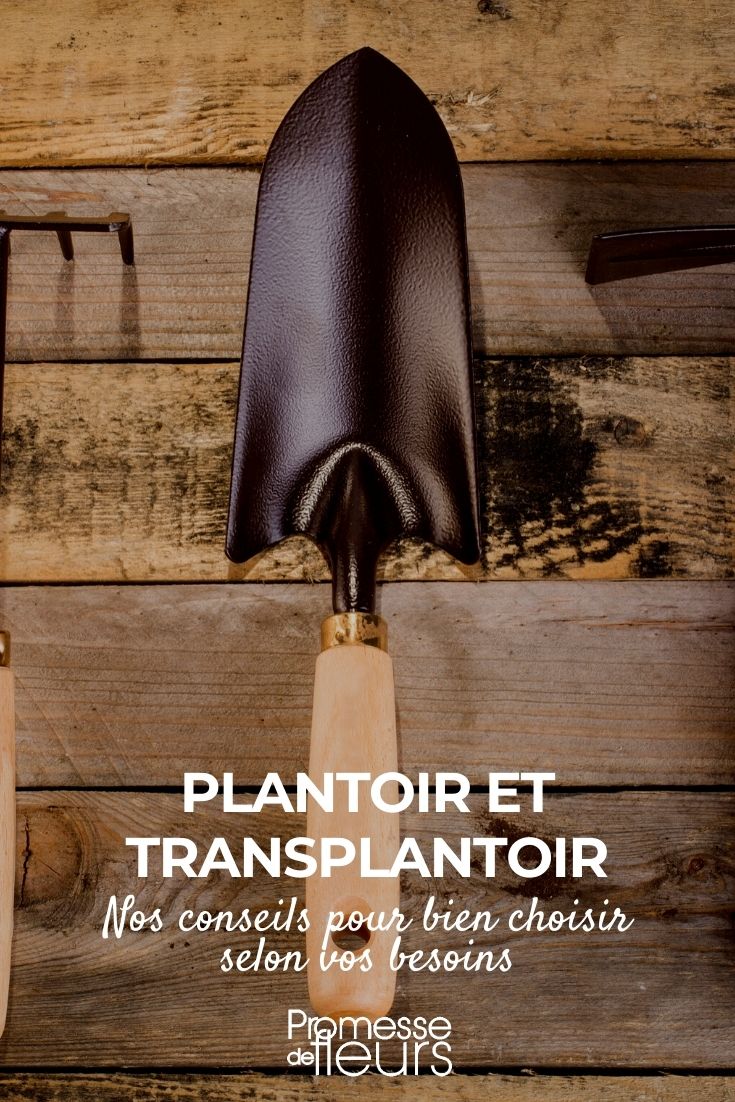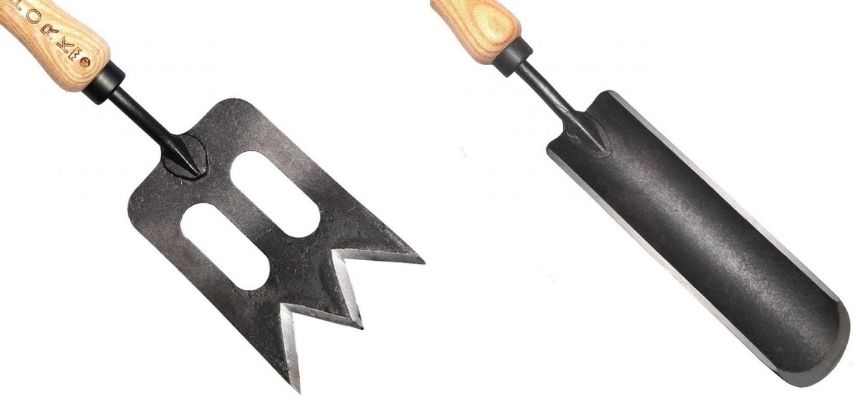
Dibber or transplanting trowel: which tool to choose depending on use?
A specific tool for every use
Contents
A dibber and a transplanting trowel are garden tools used to plant : bulbs, small perennials, very young tree plants, annual flowers or vegetables. However most of these tools can also be used to create sowing furrows as with conical dibbers, to break up compacted soil, to mix substrates or fertilisers, or even to weed! It’s easy to get lost amid the sheer variety of different dibbers and transplanting trowels available on the market. Some are specific to a particular task, others are more general-purpose and allow all kinds of uses. But which to choose? This guide looks at the various dibbers and transplanting trowels.
Traditional conical dibbers
These are the simplest dibbers. They consist of a conical metal body allowing easy penetration into soil to make a hole. Simply push the “cone” into the ground by pressing on the handle, then withdraw it. Handles are sometimes in wood or the tool is made entirely of metal; others may be made solely of wood or composite materials. These tools can be used to plant small bulbs, dig furrows for sowing, make holes in planters, plant small perennials in buckets… There are now versions with a long handle that stop the gardener having to bend down.
The traditional dibber has a long conical, pointed head and an ash handle. Simple in design, it is an extremely sturdy tool while remaining light and easy to handle. The tool itself, the cone, is hand-forged in carbon steel, with a boron-steel finish. The mirror-polished steel dibber, for its part, features a special treatment to the cone. Indeed, the cone is polished over its entire surface which prevents soil from sticking to the tool. It is a dibber as simple as it is durable.
Finally, some conical dibbers come with a long handle to avoid bending down. The handle, in wood, metal or composite materials, must measure at least 80 cm and finish with a grip or a brace. The method of use is essentially the same as for small hand-held conical dibbers.
Classic dibbers and transplanters
They look like small mini-shovels. Planting trowels are straight while transplanting trowels, sometimes called “loucheux”, are incurved to provide a slight lever effect for removing a young plant from soil and transplanting it elsewhere. Some are entirely made of metal with a blade that may or may not be polished, or fitted with a wooden handle. These small tools are not only for making holes or transplanting small plants; they can also be used to move or mix growing medium or fertilisers, break crusted soil…
Some trowels have special “heads”: for example the remarkable transplanting trowel fitted with a three-sharp-pronged, tulip-shaped head, very handy in heavy, clay soils. Or the graduated transplanting trowel specially suited to pricking out and planting bulbs. Some transplanting trowels come with a long handle of about 30 cm for working in the most inaccessible parts of the garden, or even a very long handle allowing work while standing.
Bulb planters
Although it is easy to plant small bulbs using a conical planter or a single spade planter, the ideal tool is the “true” bulb planter. The bulb planter is fitted with a “basket” that sinks into the soil. When the tool is withdrawn a small plug of soil is trapped in this basket and the hole is formed. All that remains is to place ornamental or vegetable bulbs in the hole (personally, I also plant potatoes with this type of tool).
The bulb planter can have either a fixed basket (single option!), a graduated basket, or a jointed basket. Ultimate choice is a bulb planter equipped with a polished-metal graduated and jointed basket to prevent soil sticking to the tool. The graduated basket in centimetres provides perfect accuracy for planting depth of each bulb type. The jointed basket, operated by the handle, releases the extracted soil directly into the hole. You just need to firm that soil down a little and move on to next hole. Only drawback of jointed bulb planters is that they tend to be slightly less durable over time compared with single (non-jointed) bulb planter models. There are also long-handled bulb planters to avoid needing to stoop.
→ For everything about bulb planters, we invite you to read: “Planting bulbs: which tools to choose?” and “What is a bulb planter used for?
Read also
Planting spring-flowering bulbsHighly specialised dibbers
Some dibbers have been designed for very specific tasks. This is the case for a few dibbers shown below :
Leek dibber
As its name suggests, this dibber is intended primarily for planting leeks. The leek dibber is a kind of wide 5-tined fork fitted with a large handle. This tool is really only essential if you have a passion for leeks and intend to plant 3 ha. The handle of a simple old wooden kitchen spoon works just as well to make the appropriate holes. However this type of dibber also allows creation of straight sowing furrows and loosening of compacted soil (somewhat like a broadfork).
Potato planter
It is a kind of long-handled bulb dibber but with a larger “basket” to allow passage of a potato tubercle to be planted. But you can also use this type of dibber for bulbs, for young vegetable plants or for small perennials.
Flower-pot planter
It closely resembles the potato planter but the “basket” is much larger. The hole produced allows planting of plants whose rootball would be between 11 and 15 cm in diameter.

1. Leek dibber / 2. Potato planter / 3. Flower-pot planter
All-terrain dibbers
In the exact opposite of specialised planting tools, there are also multi-purpose dibbers. This is the case of the Rock n’ Root dibber. Acting as weeder, dibber and transplanting trowel, this tool is indispensable for all gardeners. It consists of a very short natural ash handle to which is attached a head shaped like an incurved blade with sharp, honed edges. This knife-blade easily penetrates soil, even clayey or very heavy and compact, to dislodge unwanted herbs. It can also be used to scrape and loosen surface soil and, of course, to plant small plants or bulbs. Valuable for digging soil in small spaces, the weeding dibber slips between the stones of a rockery or between neighbouring plants, allowing precision work. It can also be used in vegetable beds or in flower boxes thanks to its short handle.
Along the same lines, the remarkable Spork transplanting trowel can also plant and transplant, loosen soil and weed. Part mini-fork, part mini-spade, this transplanting trowel is fitted with a sturdy head with three sharpened tines, making it extremely effective in heavy, clay soils.
Things to check before buying a dibber or transplanting trowel
- Quality materials and robust design: that’s the first thing to look for! An ash, steel or composite handle. A sturdy head in galvanised steel or treated with boron. Sharp edges where required. And solid fixing points. If all that is present, you have a quality tool in your hands.
- Let’s not forget ergonomics! Make sure when buying that the tool suits your build and isn’t too heavy to manoeuvre without fatigue over time and that every effort was made during its design to make it as ergonomic as possible. There’s nothing more frustrating than leaving a tool in the shed simply because you can’t use it without straining a muscle or injuring your foot.
- Watch out for gimmicky tools! Often simpler is better. In any case, favour, where possible, tools that have proven themselves. That doesn’t stop you trying new novelties. You never know — it might be the dibber you’ve been searching for all your life and that will completely change the way you garden.
- Value for money: no need to buy a very expensive tool if you only plan to use it twice in the season or only for light jobs (mixing potting mix, for example). Conversely, if you rely on your dibber every day you spend in the garden, consider investing in a very high-quality tool. Of course, it’s up to you based on your needs and preferences. But generally, avoid tools that are too cheap, to be honest.
- Subscribe!
- Contents



































Comments